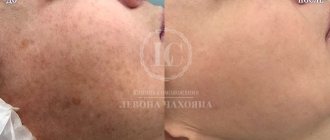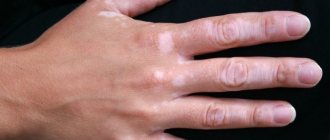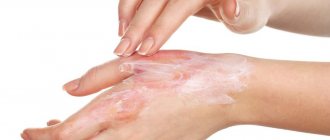Human skin color depends on melanin, a pigment produced by melanocytes - cells that lie mainly under the basement membrane. The natural color of not only our skin, but also our hair and eyes depends on the amount of melanin.
The main factor stimulating increased melanin production and the formation of pigmentation is ultraviolet radiation. By and large, this is the skin’s response to the sun’s rays - it produces more melanin for protection purposes.
But it’s one thing when the pigmentation is represented by an even, beautiful tan, the so-called physiological pigmentation, and another when the uniformity is spoiled by the appearance of elements of a different color on the skin. Where are they from?
Hyperpigmentation is excessive coloring of certain areas of the skin. This is a kind of violation, and why it occurs is a question. The reasons may be harmless. For example, this is a congenital anomaly that manifests itself in a certain area of the skin and does not cause trouble to its owner.
The most common example of an increased concentration of pigments is the already mentioned elphids.
Disruption of melanin production is also possible due to hormonal changes. For example, during pregnancy we often observe the development of so-called chloasma. The same elements may appear when taking contraceptives. After childbirth, the spots disappear on their own.
Age-related pigmentation may be associated with changes in hormonal levels. If in youth melanin is distributed evenly, then after 30 years, when the antioxidant protective properties of the skin decrease and antitumor immunity falls, there may be more of it in one place and less in another.
Skin defects must be treated from the inside
But still, don’t forget about the sun. It ages the skin and increases the risk of melanoma. It also leads to the appearance of unsightly age spots, which are most often associated with old age and unkemptness.
Sun marks on the skin are not only aesthetically unattractive, but also indicate problems in the body. And although pigment spots themselves are not considered a disease, they are a signal that something has gone wrong somewhere inside.
One of the most likely reasons for their appearance is hormonal disorders. For example, thyroid diseases, genital dysfunction, even pregnancy. In addition, hyperpigmentosis can be a symptom of a gynecological disease (primarily endometriosis).
According to dermatovenereologist, Candidate of Medical Sciences Maria Shirshakova, an experienced cosmetologist refers women who complain about pigment spots first of all to a gynecologist to rule out possible health problems. After all, any defects on the skin must be treated from the inside.
However, there may be other reasons for the appearance of “sun marks”. For example, some fungal diseases cause such a reaction on the skin. Or, for example, liver pathology (and in this case, alas, you need to prepare for long-term treatment). Acupuncturists always pay attention to the places where age spots appear, noting that they can be used to determine which specific organ is at risk.
Treatment with antibacterial drugs (especially from the tetracycline family) sometimes leads to the appearance of hyperpigmentation. In addition, the skin may react with unsightly brown spots to too intense cosmetic treatments (especially aggressive chemical peels or skin cleansing).
THE OTHER SIDE OF THE SUN. DARK SPOTS
Golubeva Marina Sergeevna, chief physician of the aesthetic medicine clinic GMTClinic, cosmetologist, dermatologist, specialist in injection and hardware techniques. Winner of the RUSSIAN BEAUTY AWARD 2016 in the category “Best Cosmetologist”. Performs all types of hardware and injection procedures, thread lifting, specializes in anti-aging programs, acts as an expert in the field of cosmetology in various media.
Irina, 56 years old: “What is the skin whitening procedure? How effective is it in getting rid of age spots? Is it painful? What time of year is it best to do it?
— There are quite a lot of lightening methods at the moment. This includes mesotherapy with lightening components, chemical peels, and, of course, photorejuvenation, laser resurfacing and laser removal of local pigment. Such procedures regulate the functioning of melanocytes and keratinocytes and significantly lighten age spots, and in many cases remove them completely. In home care, special products with retinol, vitamin C and other active ingredients are used. The pain of cosmetic procedures varies from mild to moderate, depending on individual sensitivity. Local anesthesia may be used for injection and laser procedures. Autumn and winter are the optimal time to perform such procedures, but some of them can be carried out in the summer, during the period of active sun, if you are ready to follow all the doctor’s recommendations in the post-procedure period.
Tatyana, 36 years old: “Is it true that Botox and hyaluronic acid injections can cause pigmentation if you then get exposed to the sun?”
— This statement is partly true. It is not the drug itself that provokes pigmentation, but microtrauma after a puncture with a needle. Therefore, it is recommended to refrain from sun exposure for some time, usually up to two weeks, after any injection procedures. However, there are procedures that, due to minimal trauma and a small number of injections, can be carried out a few days before going on vacation. Such procedures include botulinum therapy of individual zones and bioremodeling using the BET method, when the drug is administered at only a few points.
Elena, 32 years old: “If pigment spots already exist (for example, on the face, and appear in the sun), is it possible to get rid of them? Is it even possible to smooth out pigment spots to get an even tan?”
— There are several reasons for the formation of pigmentation defects, from genetic factors to aspects of health and lifestyle. Unfortunately, if there is a hereditary predisposition to uneven pigment formation, then it is impossible to get rid of it “completely and forever.” But we are quite capable of regulating the influence of external factors. It is recommended to visit a gynecologist-endocrinologist to rule out hormonal causes of hyperpigmentation, as well as to consult a cosmetologist and undergo a course of cosmetic procedures to remove already formed pigment spots, and then carry out maintenance procedures after exposure to the sun. Don't forget about photoprotection. Proper preparation of the skin for tanning and procedures after it will help smooth out uneven skin tone and generally improve its condition.
Yulia, 27 years old: “Tell me what to do. Second trimester of pregnancy, age spots appeared on the face. I am very worried and complex. I read that they do not always go away after childbirth. Is there anything I can do to remove it without harm? for the baby?
— All necessary procedures to remove pigmentation can be done only after the end of lactation, since any trauma to the skin during this period can provoke a worsening of the problem. For now, you should use sunscreen with an SPF of at least 30, avoid direct sunlight, and moisturize your skin with serums and creams containing hyaluronic acid. After the end of lactation, consult a cosmetologist about where exactly you should start removing pigmentation.
Anna, 30 years old: “As I got older, small moles that looked like freckles began to appear on my hands. Every year it “sprinkles” more and more, especially after the holidays. But even when the tan fades, they remain. And now they appear throughout the year. My grandmother has them all over her arms and chest, but I’m only 30! What could this be connected with and is it possible to get rid of them?
— This type of pigmentation is associated with a hereditary predisposition and, possibly, hormonal changes. You can get rid of such cosmetic defects using the methods listed above - most likely, in your case, laser procedures for local pigment removal, for example, an alexandrite laser, will be optimal. It is important to understand that a course of procedures and further maintenance of the effect are necessary. It is mandatory to use sunscreen with an SPF of at least 50 while on vacation. This is not only a matter of aesthetics, but also of safety.
Sun marks - hyperpigmentation
We have figured out the underlying causes of hyperpigmentation. But the main provocateur for the appearance of such spots is sunlight. They cause increased production by the body of cells that are responsible for skin coloring, injecting melanin pigment into it. In fact, its main task is to protect the skin from harmful UV rays. But when there is an excess of it, its protective functions are reduced. Therefore, cosmetologists never tire of repeating how important it is to use sunscreen, especially for fair-skinned and red-haired people. At the same time, it is better for Russians to buy creams or sprays with an SPF of at least 30. But many rely on chance and neglect them and like to sunbathe until black.
Any hyperpigmentation provokes early skin aging and the appearance of deep wrinkles. But this is not even the worst thing - in some cases, pigment spots can degenerate into melanoma.
How do they arise?
Ultraviolet light, when it hits the surface of the skin, has a traumatic effect on it.
It can lead to the appearance of malignant neoplasms. That is why it is very important for the body to preserve its deep layers intact. Dark color has absorbing properties and therefore prevents the penetration of rays. Some people experience abnormal melanocyte function. Due to their too intense functioning, they produce more “dye”.
Why do sun allergy symptoms occur?
The appearance of photodermatitis is promoted by internal and external causes.
Internal causes include chronic diseases of the liver and adrenal glands, some metabolic disorders, and malfunctions of the immune system. It should also be noted that people with fair skin and children are prone to photodermatitis.
External causes are the effects on the body of substances that can be divided into three large groups:
- Furocoumarins are special substances secreted by plants such as hogweed, parsnip, ash, parsley, dill, St. John's wort, and can cause allergies. Bergamot, lavender, musk, and sandalwood oils also have an allergenic effect.
- Components of cosmetics - eosin, para-aminobenzoic acid, retinoids, boric and salicylic acids, phenol, mercury compounds.
- Medicines - sulfonamides, barbiturates, aminazine, some antibiotics (doxycycline, tetracycline), some cardiovascular drugs (amiodarone, Trazicor), cytostatics, oral contraceptives, some non-steroidal anti-inflammatory drugs (indomethacin, ketoprofen, naproxen, meloxicam, diclofenac, lornoxicam) , both in the form of tablets and in the form of ointments, creams and gels.
Cosmetic peeling, permanent make-up or tattoos, even temporary ones, can also trigger photodermatitis.
Anti-pigmentation cream
Provided that the pigmentation is superficial and competent care is prescribed, which hits every link in the formation of pigmentation, it can be dealt with with cosmetics. But most often, properly selected care is, although important, still part of the treatment and, as an independent unit, is only a prevention of the strengthening of existing pigmentation and the formation of new pigment spots.
Once and for all
It is quite possible to completely get rid of pigmentation, but it is important to understand that this will require time and well-coordinated work between the doctor and the patient. The first task is to recognize the cause of pigmentation and select the most effective method of combating it. The second task is to follow skin care recommendations and fill existing deficiencies.
Replenishing the deficiency of microelements (copper, zinc, iron, ferritin, vitamin D) and correcting hormonal levels (thyroid hormones and sex hormones) is an important point that allows you to increase the regenerative function of the skin and effectively and safely use hardware methods for removing pigmentation.
The standard course of hardware removal of pigmentation is 4-6 procedures at intervals of once a month. But everything is individual and sometimes more procedures are required.
Laser treatment of pigmentation is not recommended for pregnant women, breastfeeding women, and those with severe forms of cardiovascular, endocrine, autoimmune diseases and oncology. Also an absolute but temporary contraindication is tanning less than a month old.
Dark spots after sunburn
Dark spots are caused by prolonged exposure to ultraviolet radiation on the skin, which results in burns. It may appear as reddened skin or appear as blisters. These phenomena are accompanied by headache and nausea, which disappear after some time.
KK Adapt. 5 paragraph
Sometimes dark spots against tanned skin appear due to diseases of the internal organs - liver, thyroid gland. Before sunbathing, you should not use perfume, take antibiotics or sedatives and hormonal medications.
Treating sun spots
Before you begin to treat stains, you need to find out the source of their appearance.
If it is tinea versicolor, then it is better to get rid of this disease in advance by using medications recommended by your doctor.
If it is vitiligo, then you also need to visit a doctor who will prescribe a full examination of the body. But since there is no complete confidence in the treatment of this skin defect, you can resort to folk remedies. They will help make white spots after tanning more invisible. But this is usually a temporary effect.
The easiest way to get rid of stains is those associated with excessive sweating or taking medications. To do this, it is enough to use special means or replace medications with their analogues.
If there are no particular reasons to worry about the appearance of spots after tanning, you can get rid of them with your own means. For example, take hot baths using a washcloth with stiff bristles. This will help exfoliate the top layer of the skin, which after a while will lead to an even tan. This can be facilitated by scrubs purchased in a store or made by yourself.
When treating pigment spots after sunbathing, you should use more serious means, such as special whitening creams, which should be used as prescribed by a doctor.
Use extreme caution when using products containing mercury. Since this element has toxic properties, it should not be used by pregnant women or those suffering from kidney or liver disease.
In the beginning, when using such creams, in order to avoid severe irritation, you should not wash your face with water, cleansing your face with special cleansers. As an alternative to products containing mercury, you can use creams containing salicylic alcohol, perhydrol or lactic acid.
To get rid of sun spots, beauty salons will offer chemical and ultrasound peeling and laser therapy.
How does the laser pigment spot removal procedure work?
The doctor first conducts an examination, studies the condition of the patient’s skin, identifies obvious and hidden defects, and develops a treatment plan. On the day of the manipulation, it is important to refuse decorative cosmetics, the use of creams and lotions.
When the laser is set to the desired operating mode, the doctor begins treatment. The laser beam is precisely directed to pathological areas of the skin. The impulses destroy pigment cells. And in their place, new healthy tissue will subsequently appear.
The procedure is not performed for pregnant and nursing mothers, people with skin diseases, severe mental disorders, and patients under the influence of alcohol. We ask you to take these restrictions seriously and be sure to first undergo examination by a dermatologist. Otherwise, the medical center for diagnosing moles “Lazersvit” reserves the right to refuse treatment to the visitor.
Main reasons
Despite the existence of the term “sun allergy,” sunlight itself is not an allergen. On the contrary, sunlight in safe quantities has a beneficial effect on the human body - it improves mood, promotes the absorption of vitamin D, and stimulates the immune system. Only when the ultraviolet component of sunlight interacts with any substance located on or in the skin do compounds with antigenic properties appear. It is these compounds, not the sun's rays, that cause sun allergy symptoms. Doctors call this disease “photodermatitis.”
Typically, photodermatitis can occur during periods when a person is exposed to significant sun exposure by spending a lot of time outdoors, that is, in the spring and summer. But this disease can also be provoked in winter: after all, some begin preparing for the beach season in advance by visiting a solarium, while others go to the south or to tropical countries for additional sun during the cold season. Therefore, sun allergy has become a year-round disease for many.
Pigmentation varies
The depth of the pigment in the skin depends on the causes of pigmentation and its type. In this regard, the lifetime of the pigment can indirectly indicate its depth. If the pigment has been there for several years, then we can assume that it is deep, since the surface pigment can peel off over time during the natural renewal of the top layer of skin. For example, the localization of post-inflammatory pigmentation is determined by the depth of the previous inflammatory process. It should be noted that deep-lying age spots are more difficult to remove.
Types of age spots
Age spots are classified as follows:
- Solar lentigines are pigment spots that occur against the background of age-related hormonal changes and excessive sun exposure. Most often, skin defects of this type are located in the upper part of the body - on the shoulders, on the face, on the chest.
- Freckles are small spots that appear in groups on the face, back and chest. Such skin pigmentation from the sun is the most minor cosmetic defect. Most often, freckles do not require treatment, and when the cold season approaches, when the sun loses its activity, they become less noticeable.
- Chloasma is the name given to fairly large, uneven brown spots that appear due to prolonged exposure to the sun and serious hormonal changes.









